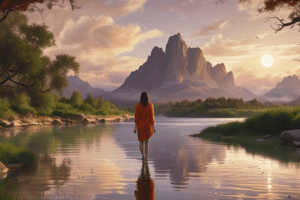Podcast
Questions and Answers
What is the main concept in photography that consists of three interconnected elements?
What is the main concept in photography that consists of three interconnected elements?
The Exposure Triangle
What is aperture in photography?
What is aperture in photography?
The size of the camera's aperture, which controls the amount of light that enters the lens
What is the effect of a larger aperture (lower f-stop) on the depth of field?
What is the effect of a larger aperture (lower f-stop) on the depth of field?
A shallower depth of field
What is shutter speed in photography?
What is shutter speed in photography?
What is the effect of a faster shutter speed on motion blur?
What is the effect of a faster shutter speed on motion blur?
What is ISO in photography?
What is ISO in photography?
What is the effect of a higher ISO value on the image?
What is the effect of a higher ISO value on the image?
How do the three elements of the Exposure Triangle interact with each other?
How do the three elements of the Exposure Triangle interact with each other?
Flashcards are hidden until you start studying
Study Notes
Understanding the Exposure Triangle
The Exposure Triangle is a fundamental concept in photography that consists of three interconnected elements: Aperture, Shutter Speed, and ISO. Mastering the Exposure Triangle is crucial for capturing well-exposed images.
Aperture
- Refers to the size of the camera's aperture, which is the opening that controls the amount of light that enters the lens
- Measured in f-stops (e.g., f/2.8, f/4, f/5.6)
- A lower f-stop value (e.g., f/2.8) means a larger aperture, while a higher value (e.g., f/16) means a smaller aperture
- Affects the depth of field: a larger aperture (lower f-stop) results in a shallower depth of field, while a smaller aperture (higher f-stop) results in a deeper depth of field
Shutter Speed
- Refers to the length of time the camera's shutter is open, measured in seconds or fractions of a second
- Faster shutter speeds (e.g., 1/1000th of a second) are used to freeze fast-moving objects, while slower shutter speeds (e.g., 1 second) are used to create motion blur
- Affects the motion and blur in an image: faster shutter speeds reduce motion blur, while slower shutter speeds increase motion blur
ISO
- Refers to the camera's sensitivity to light, measured in numerical values (e.g., ISO 100, ISO 6400)
- A lower ISO value (e.g., ISO 100) means the camera is less sensitive to light, while a higher ISO value (e.g., ISO 6400) means the camera is more sensitive to light
- Affects the noise and grain in an image: lower ISO values result in cleaner images, while higher ISO values introduce noise and grain
Interrelationship between Aperture, Shutter Speed, and ISO
- Changing one element of the Exposure Triangle affects the other two elements
- For example, increasing the aperture (lower f-stop) may require a faster shutter speed to prevent overexposure
- Understanding the interrelationship between the Exposure Triangle elements is crucial for achieving the desired exposure and creative effects in an image
Understanding the Exposure Triangle
- The Exposure Triangle consists of three interconnected elements: Aperture, Shutter Speed, and ISO.
Aperture
- Refers to the size of the camera's aperture, which controls the amount of light entering the lens.
- Measured in f-stops (e.g., f/2.8, f/4, f/5.6).
- Lower f-stop value means a larger aperture, while a higher value means a smaller aperture.
- Affects the depth of field: larger aperture (lower f-stop) results in a shallower depth of field, while a smaller aperture (higher f-stop) results in a deeper depth of field.
Shutter Speed
- Refers to the length of time the camera's shutter is open, measured in seconds or fractions of a second.
- Faster shutter speeds (e.g., 1/1000th of a second) freeze fast-moving objects, while slower shutter speeds (e.g., 1 second) create motion blur.
- Affects motion and blur in an image: faster shutter speeds reduce motion blur, while slower shutter speeds increase motion blur.
ISO
- Refers to the camera's sensitivity to light, measured in numerical values (e.g., ISO 100, ISO 6400).
- Lower ISO value (e.g., ISO 100) means the camera is less sensitive to light, while a higher ISO value (e.g., ISO 6400) means the camera is more sensitive to light.
- Affects the noise and grain in an image: lower ISO values result in cleaner images, while higher ISO values introduce noise and grain.
Interrelationship between Aperture, Shutter Speed, and ISO
- Changing one element of the Exposure Triangle affects the other two elements.
- Understanding the interrelationship between the Exposure Triangle elements is crucial for achieving the desired exposure and creative effects in an image.
Studying That Suits You
Use AI to generate personalized quizzes and flashcards to suit your learning preferences.




